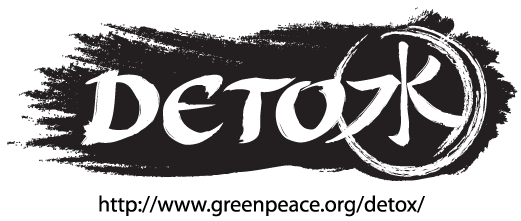 Today, on Business of Fashion, one of the most recognised fashion industry portals, Greenpeace was given the opportunity to talk amply about their Detox campaign. This comes at the back of the publication of their most recent report which outlines how dye house and finishing chemicals can be traced right into the clothes retailed and worn by the average consumer.
Today, on Business of Fashion, one of the most recognised fashion industry portals, Greenpeace was given the opportunity to talk amply about their Detox campaign. This comes at the back of the publication of their most recent report which outlines how dye house and finishing chemicals can be traced right into the clothes retailed and worn by the average consumer.
There are many things to be said about this, from various and varying angles. However, there is no doubt that Greenpeace makes an important point in what they are saying, and always has done so ever since they published their first Detox report:
The lack of transparency in supply chains is a massive problem, and – evidently now – is increasingly become both a strategic as well as operational risk for the brands.
There is equally no doubt that the actual results of the lab tests are accurate, and that the laboratories they’re using followed standardised testing procedures to get to their results.
With their Detox campaign, Greenpeace has without a question of doubt touched a sore point within what the industry at large.
And note: just because many of their products happen to be made abroad, does not mean that their results do not also apply to apparel made in Europe, and the EU in particular. There remain plenty of units across Europe that, with the help of contacts and one-hand-washes-the-other favours, manage to continue practises that from a regulatory point of view have been banned long ago.
In a few points, however, Greenpeace does their own reputation not justice. For starters, they purposely ignore (and it is purposely, because they know exactly where the practical challenges lie) that:
- some – mind you, by far not all – of those chemicals are not easily replaceable. The Roadmap to ‘Zero Discharge’ hence may face considerable practical problems by the nature of what chemicals do in dyeing. After all ‘Zero’ out practically only can mean ‘Zero’ in, i.e. no use of a particular chemical at all. And that may mean that dyeing may not be possible at all.
Or is what they mean, rather than ‘Zero, nil, niente, nothing’, ‘cannot be proven with at highest sensitivity scales in specialist labs‘? We still lack a definition of this. - EU companies, even of the size of Marks & Spencer are increasingly only ‘small fishes’ when buying from overseas suppliers. They face very real challenges in order to convince these suppliers to comply with their standards. The game of course changes once a brand owns the majority of their supply chain like e.g. Zara does. But the reality remains: most brands don’t own their supply chains, and for the sake of standards and economies of scale (which correlate to consumers expecting low prices) source from huge overseas manufacturers that produces many million units a month. To convince these suppliers to change their ways is not exactly an easy task. Blaming and shaming may not necessarily do the job, notably because there are sufficient others brands (still) that don’t ask a question.
- nearly all of the very same brands mentioned in this report are, as it happens, in an international comparison best-in-class. This is a fact that should not be forgotten, and points at the scale of the problem we’re facing. While there is a point to be made of giving a signal to the industry overall, shaming the leaders, as is partially the case here, does not necessarily help to make the industry more accessible to and open about the very real challenges that exist. It just helps cover-up activities.
- 4) Greenpeace sadly does not promote best practise along side blaming the bad ones. There are best practise dye houses out there. Only in relation to best practise, the demands put onto the specific brands show cased, and others beyond them, become tangible, verifiable and concrete.
This all said, it is evident by now that every single fashion company – be it brand or manufacturer – needs to take the risks buried and hidden in their supply chains a lot more seriously.
Not only because of campaign groups like Greenpeace, who create a huge reputational damage to the companies mentioned, but because at the back of campaigns, legislation will become progressively tighter (REACH, bio-cidal regulations, to just name 2), and more importantly because of the cost savings made by getting it right the first time around:
Taking the example of a dye house: water that needs little cleaning because of the lack of toxic chemicals in it, saves
a) money spent on chemicals and dye stuffs
b) money spent on cleaning the water
c) money spent on regulatory tests
d) money spent on fines if the tests are unfavourable, and
f) if they manage to even save on water usage, energy costs for every single process will come down, too.
These are but examples of course. A similar line up of cost-benefit analysis is easily created for virtually every single process in the fashion supply chain.
Risk management and sustainability are two sides of the same coin, and make hard-nose business sense.

